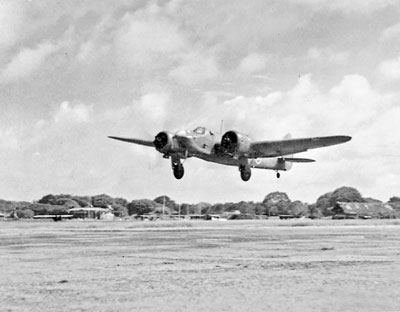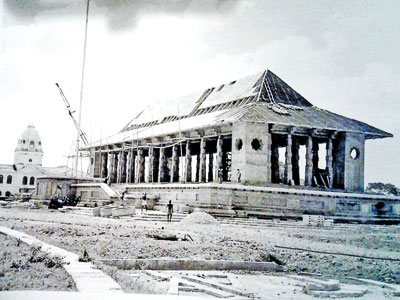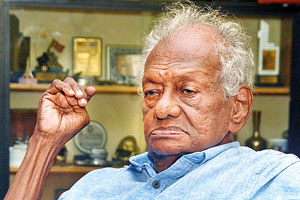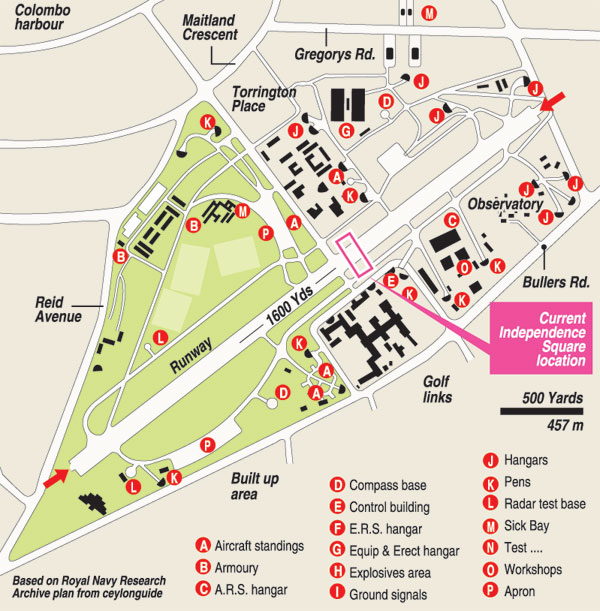Sunday Times 2
Freedom shrine rises from airfield in middle of Colombo
View(s):By Kumudini Hettiarachchi
The stone edifice of the hall with its imposing lion sculptures and statue of ‘Father of the Nation’ D.S. Senanayake who took over the leadership of independent Sri Lanka from the British colonial rulers, as the first Prime Minister, is where the formal ceremony celebrating the start of self-rule was held.
It was February 1948. But what was there before?

An RAF bomber taking off from the Colombo Racecourse during the war. (Pic courtesy ceylonguide)
It is believed that the site was home to aircraft of the Royal Air Force (RAF) and the Sunday Times went along different pathways for verification.
“I remember, as a schoolboy of Royal Prep., walking past what is now the Independence Commemoration Hall when the temporary structure was being put up for the celebration of the first Independence Day 75 years ago. The area was scattered with debris including gadol-keta (pieces of brick). Of course, it was one large open space, nothing like the built-up area of today,” recalls 85-year-old Ranjith Ratnapala, going down memory lane.
Mr. Ratnapala, who now lives in retirement in Nawala amidst his collection of books and yellowed and frayed newspapers, had later served the Royal Ceylon Air Force (RCyAF) as a Wing Commander.
He remembers hearing about how the racecourse had been an airfield, but what he walked through as a boy was barren land – from school through the grandstand entrance, past the stables (now where the National Archives is located) which housed race horses. It was curiosity that drove him because there was much talk about the coming of the rajjuruwo (king), while hordes of craftsmen, carpenters and surveyors with their theodolite were at work.
“We would look on at the activity and then go further to McCarthy Road (now Wijerama Mawatha) looking in wonder at the stately buildings, two of which were the homes of the then Chief Justice Sir Alan Rose and the first Governor of the Central Bank John Exter.
The Sunday Times, meanwhile, got in touch with the British authorities to gather information which may be buried in the dim mists of time, whether RAF hangars did occupy the Independence Hall site back in 1948.
This is what the RAF’s Air Historical Branch (AHB) based in Ruislip, Middlesex, United Kingdom stated: “We believe that the hangars on the site of the Independence Memorial Hall belonged to RAF Colombo Racecourse, which was a temporary RAF station constructed during the war. Unfortunately, we have very little in the Branch which is directly relevant to this RAF station and we have no file for it. Our card index entry tends to only detail units at Colombo…. We have consulted our Photographic Archivist but unfortunately, we do not have any relevant images.”

The majestic Independence hall under construction
The AHB points us in the direction of the piece ‘An airfield in the middle of Colombo’ from the ‘ceylonguide’, which describes itself as “an online archive of the good old Ceylon days” with the goal of collecting and sharing photographs and information about the journey from Ceylon to Sri Lanka.
A plan shows the airfield, with a number of hangars (J) marked on it, notably near the Observatory and on the north-east of the plan.
‘An airfield in the middle of Colombo’ credited to Henrik Melder, Wikipedia, describes how in late 1941, World War II began in the East. After the fall of Singapore, the Royal Navy’s East Indies Station was moved to Colombo and then to Trincomalee. Admiral Sir Geoffrey Layton was appointed Commander-in-Chief, Ceylon with Air Vice Marshal John D’Albiac as air officer commanding No. 222 Group RAF which was based in Ceylon.
“The order was given to construct an airfield at the Colombo Racecourse. D.S. Senanayake, Minister of Agriculture and Lands (later the 1st Prime Minister of Ceylon), was given the task of its construction. Consisting only of a single runway, station headquarters and the officers’ mess were set up in the bungalows in Cinnamon Gardens and was serviced by a newly established military hospital in the premises of Royal College, Colombo,” states Melder.
He goes on to say that the Japanese knew about the Ratmalana Civil Airport. However, they did not know about the airport at the Racecourse, in the heart of the city. One end of the Runway was near McCarthy (now Wijerama) Road, Colombo 7 and the other end was at the ‘Thunmulla’ Junction. (The SSC, Independence Hall and other playgrounds came later). The RAF 258 Squadron of Hurricanes was parked there. The fences down Reid Avenue had been removed and the aircraft even parked at the University College grounds, where the Government Farm had been, before it was relocated to Narahenpita.
Melder gives a colourful description of the Japanese raid over then Ceylon……..“During the April 1942 air raid, as soon as the news was received that the Ratmalana airport and the Railway workshops were under attack, the Hurricanes from the Racecourse got airborne and started climbing frantically to 10,000ft to gain an altitude advantage over the enemy. While climbing they observed that the Japanese dive bombers had already started their attack over the harbour. So they were forced to engage the enemy, from the east, with the sun behind them. This caught the Japanese off-guard. The ‘Hurries’ being heavier could out-dive the Zeros, but at slow speeds, the Zero was more manoeuvrable.”
The Royal Navy also established a Royal Naval Air Station (RNAS) here during the war with the name HMS Bherunda. 882 Naval Air Squadron was based here, he adds.
The AHB, meanwhile, goes into detail that the two RAF squadrons initially based at Colombo Racecourse were No. 258 with Hawker Hurricanes and No. 11 Squadron with Bristol Blenheims. The former tried to intercept the Japanese raiders attacking Colombo on April 5, 1942. The Hurricanes at Colombo Racecourse focused on harbour defence, whilst the Hurricanes at Ratmalana concentrated on the defence of the aerodrome.

Retired RAF Wing Commander Ranjith Ratnapala
“No. 258 Squadron had been cobbled together from remnants of an RAF squadron destroyed in Sumatra, Indonesia. The Squadron was in the process of moving from Ratmalana to the Racecourse before the attack. The Japanese were seemingly not aware of the existence of the Racecourse RAF facility. The Squadron lost 7 of its 14 Hurricanes scrambled. No. 30 Squadron at Ratmalana lost 8 of its 22 Hurricanes scrambled. The Royal Navy’s Fleet Air Arm lost four out of the six Fulmers scrambled,” says AHB.
While pointing out that when he was researching independence, he read that D.S. Senanayake who was a draftsman had called Chief Architect Wynne Jones to brief him that the Independence Hall should reflect the audience hall in Kandy, where the country lost its independence, retired Wing Commander Ratnapala also explains Air Force language: “When the siren sounds, pilots are required to ‘scramble’ to their aircraft for immediate takeoff.”


